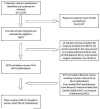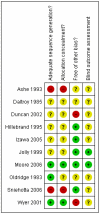Promoting patient uptake and adherence in cardiac rehabilitation
- PMID: 20614453
- PMCID: PMC4164451
- DOI: 10.1002/14651858.CD007131.pub2
Promoting patient uptake and adherence in cardiac rehabilitation
Update in
-
Promoting patient uptake and adherence in cardiac rehabilitation.Cochrane Database Syst Rev. 2014 Jun 25;(6):CD007131. doi: 10.1002/14651858.CD007131.pub3. Cochrane Database Syst Rev. 2014. Update in: Cochrane Database Syst Rev. 2019 Feb 01;2:CD007131. doi: 10.1002/14651858.CD007131.pub4. PMID: 24963623 Updated.
Abstract
Background: Cardiac rehabilitation is an important component of recovery from coronary events but uptake and adherence to such programmes are below the recommended levels. This aim is to update a previous non-Cochrane systematic review which examined interventions that may potentially improve cardiac patient uptake and adherence in rehabilitation or its components and concluded that there is insufficient evidence to make specific recommendations.
Objectives: To determine the effects of interventions to increase patient uptake of, and adherence to, cardiac rehabilitation.
Search strategy: A previous systematic review identified studies published prior to June 2001. We searched the Cochrane Central Register of Controlled Trials (CENTRAL) in The Cochrane Library (Issue 4 2007), MEDLINE (2001 to January 2008), EMBASE (2001 to January 2008), CINAHL (2001 to January 2008), PsycINFO (2001 to January 2008), Web of Science: ISI Proceedings (2001 to April 2008), and NHS Centre for Reviews and Dissemination (CRD) databases (Health Technology Assessment (HTA) and Database of Abstracts of Reviews of Effects (DARE)) from 2001 to January 2008. Reference lists of identified systematic reviews and randomised control trials (RCTs) were also checked for additional studies.
Selection criteria: Adults with myocardial infarction, coronary artery bypass graft, percutaneous transluminal coronary angioplasty, heart failure, angina, or coronary heart disease eligible for cardiac rehabilitation and randomised or quasi-randomised trials of interventions to increase uptake or adherence to cardiac rehabilitation or any of its component parts. Only studies reporting a measure of adherence were included.
Data collection and analysis: Titles and abstracts of all identified references were screened for eligibility by two reviewers independently and full papers of potentially relevant trials were obtained and checked. Included studies were assessed for risk of bias by two reviewers.
Main results: Ten studies were identified, three of interventions to improve uptake of cardiac rehabilitation and seven of interventions to increase adherence. Meta-analysis was not possible due to multiple sources of heterogeneity. All three interventions targeting uptake of cardiac rehabilitation were effective. Two of seven studies intended to increase adherence had a significant effect. Only one study reported the non-significant effects of the intervention on cardiovascular risk factors and no studies reported data on mortality, morbidities, costs or health care resource utilisation.
Authors' conclusions: There is some evidence to suggest that interventions to increase the uptake of cardiac rehabilitation can be effective. Few practice recommendations for increasing adherence to cardiac rehabilitation can be made at this time. Interventions targeting patient identified barriers may increase the likelihood of success. Further high quality research is needed.
Figures



References
References to studies included in this review
-
- Ashe ED. The effects of a relapse prevention program on adherence to a phase II cardiac exercise program. PhD Thesis. Florida State University; Florida: 1993. Florida: Florida State University.
-
- Daltroy LH. Improving cardiac patient adherence to exercise regimens: a clinical trial of health education. Journal of Cardiac Rehabilitation. 1985;5:40–9.
-
- Duncan K, Pozehl B. Staying on course: the effects of an adherence facilitation intervention on home exercise participation. Progress in Cardiovascular Nursing. 2002;17(2):59–65. 71. - PubMed
-
- Duncan K, Pozehl B. Effects of an exercise adherence intervention on outcomes in patients with heart failure. Rehabilitation Nursing. 2003;28(4):117–22. - PubMed
-
- Hillebrand T, Frodermann H, Lehr d, Wirth A. Vermehrte Teilnahme an ambulaten Herzgruppen durch poststation are Nachsorge [Increased participation in coronary groups by means of an outpatient care program] Herz Kreislauf. 1995;27:346–9.
References to studies excluded from this review
-
- Aish AE, Isenberg M. Effects of Orem-based nursing intervention on nutritional self-care of myocardial infarction patients. International Journal of Nursing Studies. 1996;33(3):259–70. - PubMed
-
- Brodie D, Inoue A. Motivational interviewing to promote physical activity for people with chronic heart failure. Journal of Advanced Nursing. 2005;50(5):518–27. - PubMed
-
- Carroll D, Rankin S, Cooper B. The effects of a collaborative peer advisor/advanced practice nurse intervention: cardiac rehabilitation participation and rehospitalization in older adults after a cardiac event. Journal of Cardiovascular Nursing. 2007;22(4):313–9. - PubMed
-
- Duncan K, Pozehl B, Rosado K. The effects of behavioural feedback on adherence to dietary sodium intake for patients with congestive heart failure. Journal of Cardiopulmonary Rehabilitation. 2001;21:304.
-
- Froelicher E, Miller N, Buzaitis A, Pfenninger P, Misuraco A, Jordan S, et al. The Enhancing Recovery in Coronary Heart Disease Trial ENRICHD: strategies and techniques for enhancing retention of patients with acute myocardial infarction and depression or social isolation. Journal of Cardiopulmonary Rehabilitation. 2003;23(4):269–80. - PubMed
References to ongoing studies
-
- Beckie TM. A behavior change intervention for women in cardiac rehabilitation. Journal of Cardiovascular Nursing. 2006;21(2):146–53. - PubMed
Additional references
-
- Ajzen I, Madden TJ. Prediction of goal-directed behaviour: attitudes, intentions and perceived behavioural control. Journal of Experimental Social Psychology. 1986;22:453–74.
-
- Al-Ali N, Haddad LG. The effect of the health belief model in explaining exercise participation among Jordanian myocardial infarction patients. Journal of Transcultural Nursing. 2004;15(2):114–21. - PubMed
-
- Balady GJ, Williams MA, Ades PA, Bittner V, Comoss P, Foody JM, et al. Core components of cardiac rehabilitation/secondary prevention programs: 2007 update: a scientific statement from the American Heart Association Exercise, Cardiac Rehabilitation, and Prevention Committee, the Council on Clinical Cardiology; the Councils on Cardiovascular Nursing, Epidemiology and Prevention, and Nutrition, Physical Activity, and Metabolism; and the American Association of Cardiovascular and Pulmonary Rehabilitation. Circulation. 2007;115(20):2675–82. - PubMed
-
- Bethell HJ, Turner SC, Evans JA, Rose L. Cardiac rehabilitation in the United Kingdom. How complete is the provision? Journal of Cardiopulmonary Rehabilitation. 2001;21(2):111–5. - PubMed
-
- Blackburn GG, Foody JM, Sprecher DL, Park E, Apperson-Hansen C, Pashkow FJ. Cardiac rehabilitation participation patterns in a large, tertiary care center: evidence for selection bias. Journal of Cardiopulmonary Rehabilitation. 2000;20(3):189–95. - PubMed
References to other published versions of this review
-
- Beswick AD, Rees K, Griebsch I, Taylor FC, Burke M, West RR, et al. Provision, uptake and cost of cardiac rehabilitation programmes: improving services to under-represented groups. Health Technology Assessment. 2004;8(41) - PubMed
-
- Beswick AD, Rees K, West RR, Taylor FC, Burke M, Griebsch I, et al. Improving uptake and adherence in cardiac rehabilitation: literature review. Journal of Advanced Nursing. 2005;49(5):538–55. - PubMed
-
-
* Indicates the major publication for the study
-
Publication types
MeSH terms
LinkOut - more resources
Full Text Sources
Medical
Miscellaneous

